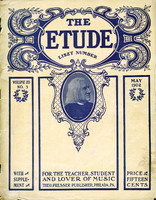Mr. Arnold Dolmetsch, a noted musician and piano-expert of London, contributed an interesting article to a London paper on “The Modern Piano and the Modern Virtuoso,” from which we have reprinted the following:
“The gorgeous tone these highly trained athletes can produce entirely fills the very largest halls, and they can compete with an orchestra of a hundred performers. But the original nature of the instrument has become entirely transformed. The delicate chamber-music of Mozart and Beethoven can no longer be realized by means of them. The tone of stringed instruments not having increased in the same proportion, no violin or violoncello has a chance of being heard in connection with a piano-player doing full justice to his instrument. If the player be a delicate artist—there are such—the softened tone is too muffled and dull to blend with that of the violins. Besides, there is a want of equality between a violin-player for all he is worth and the piano that spares him which is fatal to concerted chamber-music. The solo pianoforte works of Beethoven are also in a great measure altered on the transformed instrument. Beethoven frequently writes full, close chords very low down the scale, which, though beautiful on the comparatively thin-toned instrument of his time, only make a confused noise on the modern ones. Then he frequently requires the una corda pedal, which has had to be sacrificed. Even the music of Chopin and Schumann can no longer be heard in anything approaching the balance of tone intended by its composer.
The Piano of the Future.
“Still, with all its faults, the modern piano is a necessity, and will be regarded as such so long as the present demand for loudness before anything else will endure. Moreover, its existence is justified by the effects which can be produced on it by great players. But in an ordinary room an instrument of this caliber is out of place. The average amateur has no more hope of being able to bring out its qualities than of rivaling the athletic feats of Sandow. It is true that pianos of reduced size are made for those who have not the room or the means of indulging in a full-sized one. But the reduction is made practically in one direction only, namely: in the length of the instrument. The bass strings are shortened, but made thicker in proportion, which injures the quality of the tone without much reducing its volume. Besides, the shortened instrument becomes so shapeless that no outside decoration can disguise it, and its presence in a beautiful room is rendered impossible.
“No very material increase of power in pianos seems probable at present. A reaction, sooner or later, is inevitable; and signs are not wanting that it has already begun. Some of our leading pianists know quite well that the growth of the pianoforte has not been an unmitigated good, and they are looking for progress in another direction.”



